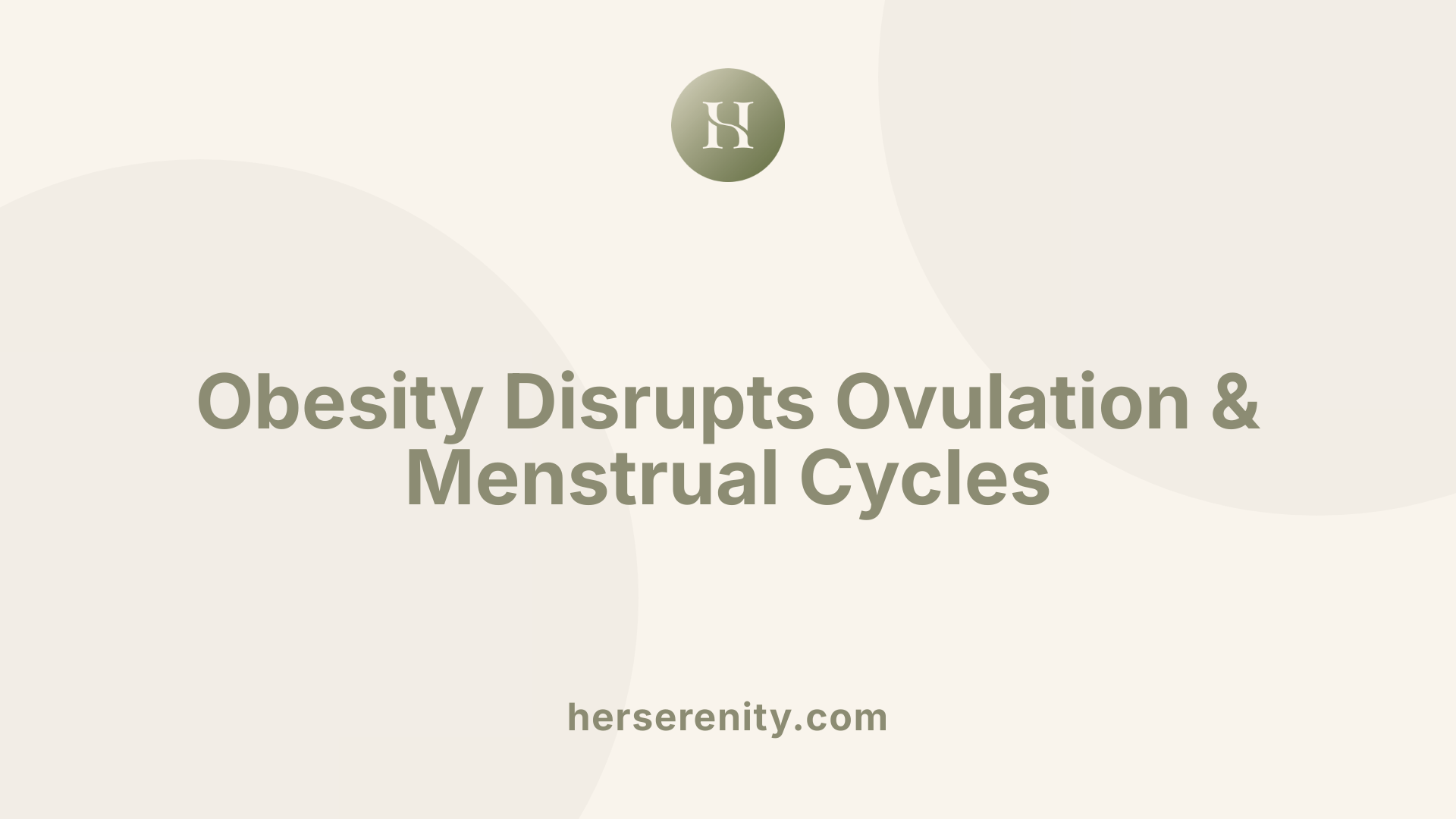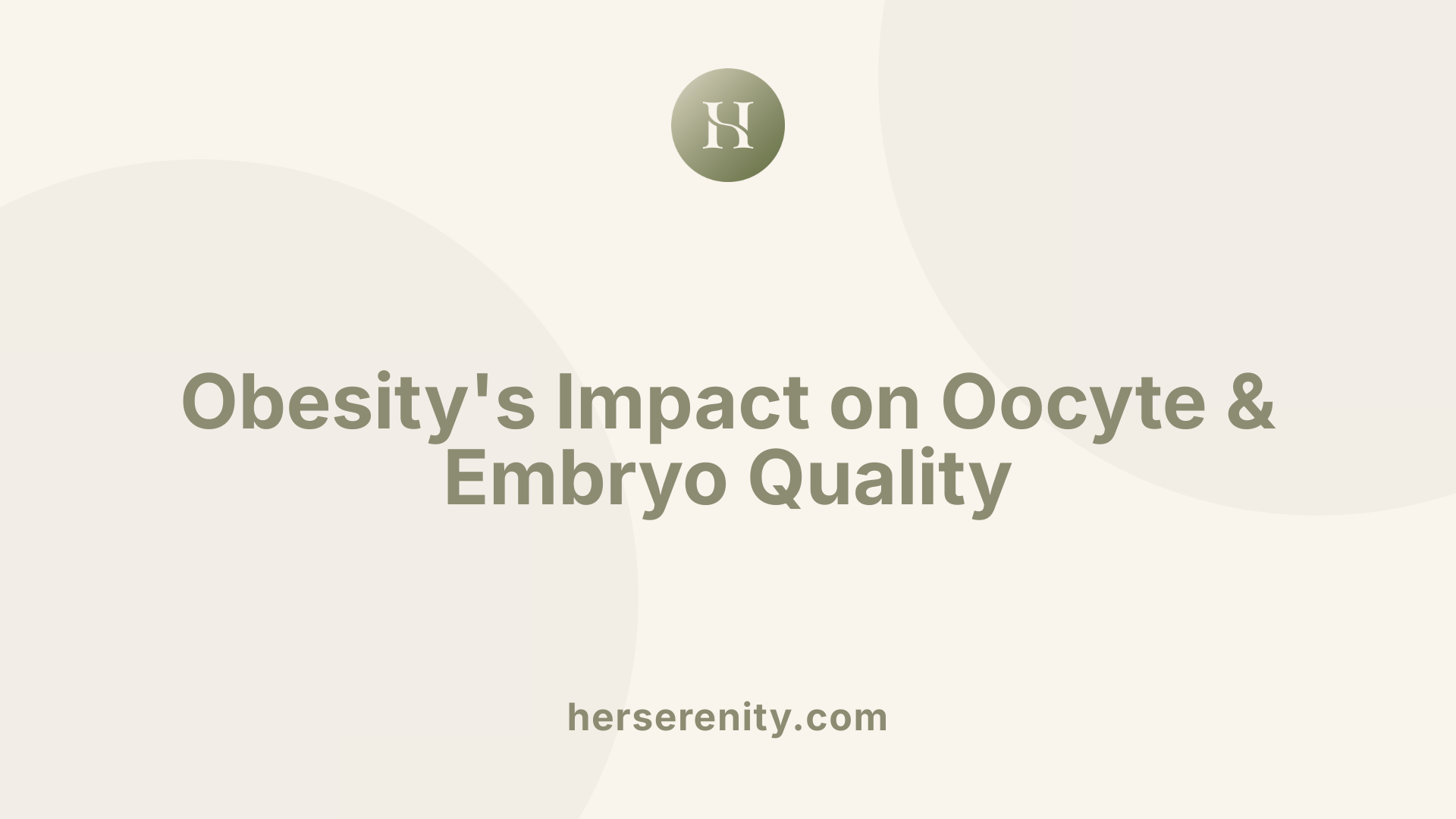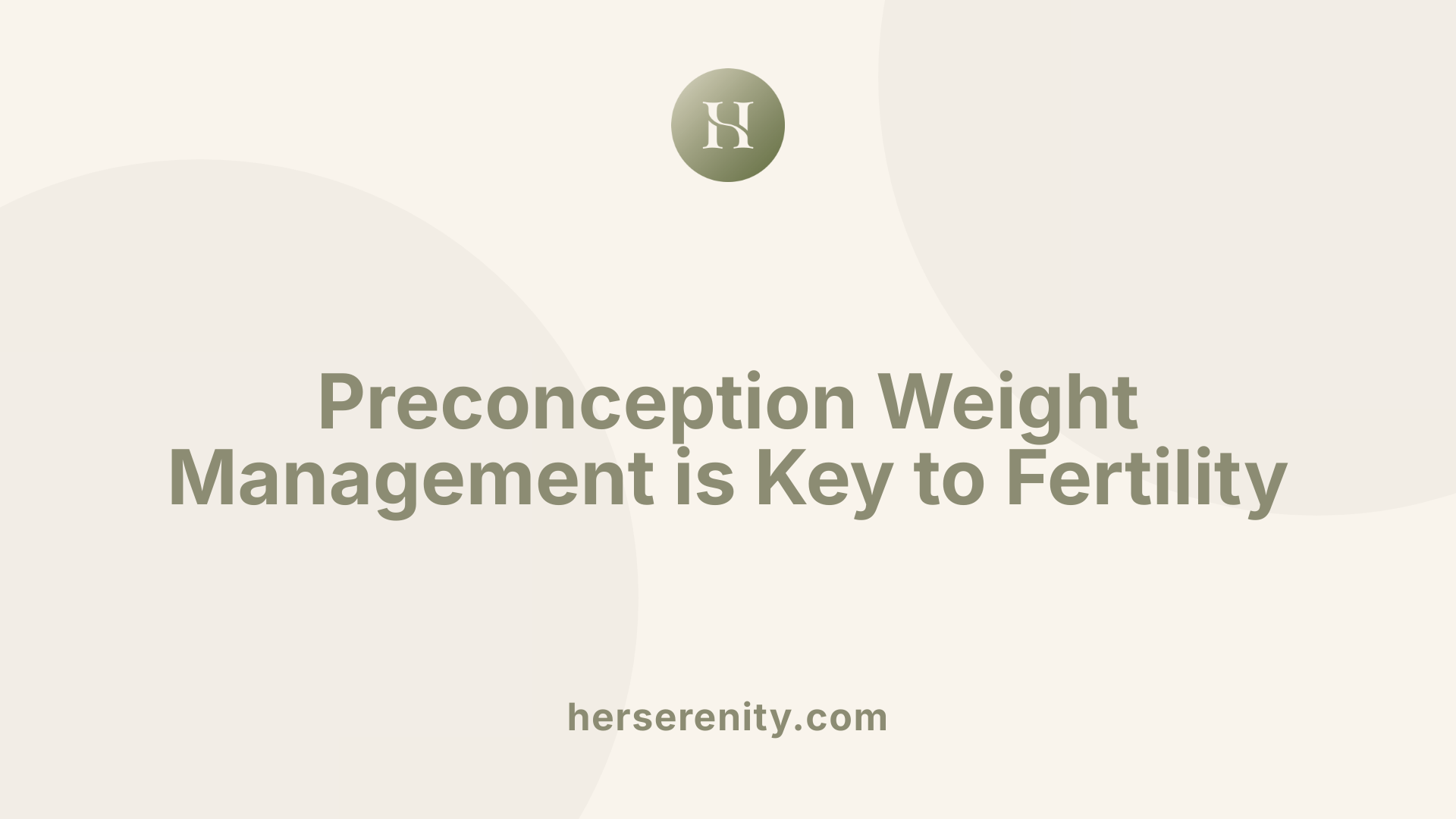Does body weight impact fertility and IVF outcomes?
How Body Weight Influences Fertility and Assisted Reproductive Success

Understanding the Connection Between Body Weight, Fertility, and IVF Outcomes
The complex relationship between body weight and reproductive health is increasingly influencing fertility treatment approaches. With obesity rates rising globally, its impact on natural conception and assisted reproductive technologies such as in vitro fertilization (IVF) commands critical attention. This article explores how body weight affects fertility, the challenges posed during fertility treatments, and how weight management can improve reproductive outcomes.
Impact of Obesity on Female Fertility: Ovulation and Menstrual Function

How Does Obesity Affect Ovulation and Menstrual Cycles?
Obesity has a profound impact on female fertility, mainly through its effects on ovulation and menstrual function. Women with a high body mass index (BMI) exceeding 32 kg/m² are about 2.7 times more likely to experience anovulatory infertility compared to women with normal weight. This means their ovaries fail to release eggs regularly, which directly hinders the ability to conceive.
What Role Does Obesity Play in Polycystic Ovary Syndrome (PCOS)?
Obesity increases the risk of developing conditions like Polycystic Ovary Syndrome (PCOS), a hormonal disorder characterized by irregular menstrual cycles and chronic anovulation. PCOS is a common cause of infertility, and excess body fat can worsen the symptoms, making ovulation even more unpredictable.
How Does This Affect Time to Conception?
Due to ovulatory dysfunction and irregular menstruation linked to obesity, women often face a longer time to conception. The difficulties in ovulation regulation delay the chance of natural pregnancy, emphasizing the need for weight management as part of fertility care.
Overall, obesity disrupts reproductive hormone balance and menstrual cycle regularity, contributing significantly to challenges in achieving pregnancy. Maintaining a healthy weight can improve ovulation frequency, menstrual cycle stability, and ultimately, fertility outcomes.
How Obesity Affects Fertility Treatments and Ovarian Stimulation
How does obesity interfere with ovarian stimulation during fertility treatments?
Women with obesity often face challenges with ovarian stimulation during fertility treatments. One of the main issues is a poorer response to ovulation induction agents like clomiphene citrate. Due to the altered hormonal and metabolic environment associated with obesity, these women tend to require higher doses of gonadotrophins to stimulate the ovaries effectively.
This increased demand for stimulation results in a reduced ovarian response. Specifically, obese women undergoing assisted reproduction typically produce fewer follicles, which are essential for ovulation and egg retrieval. Consequently, fewer oocytes (eggs) are harvested during procedures like in vitro fertilization (IVF).
The diminished ovarian responsiveness also raises the risk of cycle cancellation, where stimulation protocols fail to produce sufficient follicles for egg collection. Additionally, technical difficulties during oocyte retrieval, such as challenging venous access and complications with sedation due to higher body mass index (BMI), make the process more complex.
Overall, obesity complicates the ovarian stimulation process by:
- Impairing response to standard ovulation induction like clomiphene citrate
- Necessitating higher gonadotrophin doses
- Producing fewer follicles and retrieving fewer oocytes
- Increasing the likelihood of cycle cancellation and procedural difficulties
Understanding these factors highlights the importance of individualized protocols and possibly weight management interventions prior to fertility treatments to improve outcomes for women with obesity.
Effects of Obesity on Oocyte and Embryo Quality

How Does Obesity Impair Oocyte Quality and Affect the Follicular Environment?
Obesity negatively influences the quality of oocytes by altering the follicular environment in which they develop. Women with obesity tend to have smaller oocytes and changes in follicular fluid composition, which may disrupt crucial processes for egg maturation. These alterations can reduce the overall developmental potential of the oocytes, making them less viable for fertilization and subsequent embryo development.
Are Fertilization Rates Lower in Younger Obese Women?
Studies have found that younger women with obesity, particularly those under the age of 35, experience lower fertilization rates compared to women with a normal body mass index (BMI). This suggests that obesity's impact on reproductive outcomes is not limited to older age groups but can affect younger women by reducing the chances of successful fertilization during in vitro fertilization (IVF) cycles.
How Does Obesity Affect Early Embryonic Development and Embryo Quality?
Embryo quality can be compromised in women with obesity. The negative effects on oocytes translate into embryos with impaired early developmental competence. Embryos from obese women often show decreased quality, which can reduce implantation rates and overall pregnancy success. Some studies indicate that the impact on embryos is linked to changes in metabolism and inflammation associated with obesity.
| Aspect | Effect of Obesity | Impact on IVF Outcomes |
|---|---|---|
| Oocyte Quality | Altered follicular environment, smaller and less viable oocytes | Lower likelihood of successful egg retrieval and maturation |
| Fertilization Rates | Reduced fertilization especially in women <35 years | Fewer embryos formed and decreased IVF efficiency |
| Embryo Quality | Poorer embryo morphology and early development | Lower implantation rates, increased risk of pregnancy loss |
In summary, obesity diminishes oocyte and embryo quality, directly reducing the success rates of assisted reproduction techniques. Weight management before fertility treatments can help improve these reproductive parameters and IVF outcomes.
Body Weight and IVF Success Rates: Pregnancy and Live Birth Outcomes
How does body weight affect IVF pregnancy success and live births?
Higher body mass index (BMI), especially values exceeding 30 kg/m², has been consistently associated with lower success rates in in vitro fertilization (IVF). Women with elevated BMI often experience reduced pregnancy and implantation rates. This reduction is influenced by multiple factors including impaired egg quality, altered follicular environments, and compromised endometrial receptivity.
Furthermore, obesity contributes to an increased risk of early pregnancy loss and miscarriage. Studies have documented that obese women face higher chances of pregnancy complications such as early fetal loss after both spontaneous conception and assisted reproduction treatments. Miscarriage rates are notably elevated, which decreases overall IVF effectiveness.
Despite these challenges, the evidence regarding live birth rates among obese patients is somewhat mixed. While several studies report decreased live birth rates in women with obesity, others find no significant differences when compared to women of normal weight. These discrepancies highlight the complexity of obesity's impact on reproductive success and suggest that additional factors, including age, metabolic health, and body fat distribution, might modulate outcomes.
Clinicians recommend weight management strategies before IVF to improve reproductive outcomes. Even modest weight loss of 5–10% has shown beneficial effects on fertility and may enhance pregnancy success. However, sustained and carefully managed weight reduction is crucial to avoid potential negative effects from rapid dieting or excessive exercise.
| Factor | Impact on IVF Outcomes | Notes |
|---|---|---|
| High BMI (>30 kg/m²) | Lower pregnancy and implantation rates | Linked to poorer egg quality, hormone imbalances, and implantation difficulties |
| Obesity-related miscarriage risk | Increased early pregnancy loss | Applies to natural conception and IVF; risk elevated in both scenarios |
| Live birth rates | Mixed findings | Some studies show reduced rates; others show no significant effect |
| Weight loss | Improves fertility and pregnancy rates | Even modest loss beneficial; sustained approaches recommended over rapid weight reduction |
Understanding how body weight influences IVF success aids in optimizing fertility treatment plans and counseling for women facing obesity-related challenges.
Challenges in IVF Procedure for Women with High BMI
What procedural challenges does obesity introduce during IVF treatments?
Women with high body mass index (BMI) face several specific challenges during IVF procedures, particularly during oocyte retrieval. The positioning of ovaries in obese women often complicates their visualization and accessibility via ultrasound, which is critical for guiding needle aspiration during egg collection. This difficulty can result in fewer oocytes being harvested, impacting the overall success rate of IVF.
Additionally, obesity increases the risks related to procedural sedation and anesthesia. Women with elevated BMI may have altered responses to sedative drugs, complicating anesthesia management and potentially increasing perioperative risks.
Venous access poses another significant challenge. In obese patients, it can be more difficult for clinicians to locate suitable veins for intravenous drug administration, which adds complexity and discomfort to the procedure. These factors combined increase the likelihood of cycle cancellations and may require higher doses of medications to achieve adequate ovarian stimulation.
Overall, the combination of technical difficulties in egg retrieval, increased anesthesia-related risks, and venous access complications collectively make IVF procedures more challenging for women with obesity, necessitating specialized care and individualized treatment strategies.
Influence of Male Obesity on Fertility and IVF Outcomes
How does male obesity affect fertility and IVF success?
Male obesity has a significant impact on fertility, affecting various aspects of reproductive function. Obesity in men is associated with reduced semen quality and decreased sperm motility, both crucial factors for successful fertilization. Furthermore, obese males often experience hormonal imbalances characterized by lower testosterone levels, which can impair sperm production and function.
These hormonal changes also contribute to potential sperm DNA damage, which may negatively influence embryo development and pregnancy outcomes. When both partners are overweight or obese, the combined effect can be even more detrimental, leading to further reductions in embryo quality and fertilization rates during IVF treatments.
Reduced semen quality and sperm motility
Obese men frequently have lower sperm counts and diminished motility, which hinders the ability of sperm to reach and fertilize the egg. This decrease in sperm health contributes to overall reduced natural fertility and can complicate assisted reproductive techniques like IVF.
Hormonal imbalances influencing male reproductive function
Excess body fat disrupts the balance of reproductive hormones, notably reducing testosterone levels while increasing estrogen. This hormonal disruption affects spermatogenesis and may lead to impaired sperm function and an increased risk of infertility.
Combined overweight in both partners reducing embryo quality
Studies show that when both the male and female partners are overweight or obese, the quality of embryos formed during IVF is further compromised. This combined effect negatively influences fertilization rates and early embryo development, highlighting the importance of managing weight in both partners to optimize fertility treatment outcomes.
Weight Loss and Its Positive Influence on Fertility and IVF Success
How Does Modest Weight Loss Affect Ovulatory Function?
Losing just 5–10% of body weight can have a profound impact on fertility in obese women. This degree of weight loss helps regulate menstrual cycles and increases the likelihood of spontaneous ovulation. By improving ovulatory function, women become more fertile naturally, reducing the need for more invasive fertility treatments.
What Are the Pregnancy Benefits Associated with Weight Loss Interventions?
Weight loss interventions have been linked to increased chances of pregnancy. Studies show that women who participate in these programs experience a 21% higher likelihood of achieving pregnancy either spontaneously or through assisted reproductive technologies like IVF. Notably, obese women who lose weight before IVF are 47% more likely to conceive naturally compared to those who do not engage in weight loss support.
Which Weight Loss Methods Contribute to Improved Fertility?
Several approaches have proven effective for enhancing fertility outcomes through weight management:
- Lifestyle Modifications: Nutritional changes combined with regular exercise help achieve gradual and sustained weight loss, which is crucial for fertility enhancement.
- Medications: Drugs such as orlistat and glucagon-like peptide-1 (GLP-1) agonists have been used to support weight loss efforts, yielding additional benefits for reproductive function.
- Bariatric Surgery: For some women with severe obesity, surgical interventions offer substantial weight reduction that may improve fertility and reduce pregnancy complications.
Although there is clear evidence supporting increased pregnancy rates linked to weight loss, the impact on live birth rates remains uncertain and requires further research.
| Aspect | Effect of 5–10% Weight Loss | Details |
|---|---|---|
| Ovulatory Function | Improved menstrual regularity | Leads to increased spontaneous ovulation |
| Pregnancy Odds | Increased by 21% | Includes natural conception and assisted methods |
| IVF Success | 47% more likely to conceive naturally | Particularly in obese women undergoing IVF |
| Intervention Types | Lifestyle, medications, surgery | Effective strategies include diet, exercise, orlistat, GLP-1 agonists, and bariatric surgery |
Modest and sustained weight reduction is a proven strategy to enhance fertility and IVF outcomes, underscoring the importance of weight management in reproductive health.
Multidisciplinary Approach to Managing Fertility in Women with Obesity
Comprehensive Preconception Counseling
Women with obesity seeking fertility treatment benefit significantly from thorough preconception counseling. This counseling focuses on the importance of weight management and lifestyle modifications such as diet and exercise. Even modest weight loss, around 5–10%, can markedly improve fertility by restoring menstrual regularity and spontaneous ovulation. Preconception counseling also addresses potential pregnancy risks, including higher rates of miscarriage and obstetric complications common in obese women.
Individualized Clinical Assessment and Safety Considerations
Fertility treatment in women with obesity requires careful, personalized clinical evaluation. Medical professionals assess each patient's health status, including body composition and metabolic function, to tailor safe and effective treatment plans. Because obesity is linked with poor ovarian response, increased gonadotrophin needs, and higher cycle cancellation risks, practitioners weigh these factors along with procedural risks such as difficulties in oocyte retrieval and anesthesia complications. This individualized approach balances maximizing treatment success while minimizing safety concerns.
Involvement of Specialists for Optimizing Treatment Outcomes
Optimal management relies on a multidisciplinary team, including reproductive endocrinologists, nutritionists, anesthesiologists, and counselors. Nutritionists guide weight loss interventions that improve fertility outcomes, while anesthesiologists prepare for potential procedural challenges associated with high BMI. Psychologists and counselors support patients emotionally throughout complex fertility treatments. Collaborative care ensures a comprehensive strategy addressing the physical and emotional complexities of infertility linked to obesity.
How do medical professionals tailor fertility treatments for women with obesity?
Management involves a multidisciplinary team that provides individualized assessments including evaluation for procedural safety and pregnancy risks. Preconception counseling addresses weight management strategies and personalized treatment protocols, optimizing both the safety and effectiveness of fertility interventions.
This integrative approach helps improve pregnancy rates and reduces complications, supporting women with obesity on their path to parenthood.
Common Medical Treatments to Assist Conception and IVF Success

What Are the Common Medical Treatments Available to Assist Individuals and Couples with Conception?
Several medical treatments help individuals and couples facing infertility to conceive. Fertility medications are often the first step, with clomiphene citrate used to stimulate ovulation in women with ovulatory dysfunction, including those affected by obesity-related anovulation. Gonadotrophins can also be administered to induce ovulation or optimize ovarian response, especially in women who require higher doses due to a higher BMI.
Assisted reproductive technologies (ART) like intrauterine insemination (IUI) and in vitro fertilization (IVF) offer additional routes to conception. IUI involves placing washed sperm directly into the uterus to increase the chance of fertilization. IVF, which includes ovarian stimulation, egg retrieval, fertilization in the lab, and embryo transfer, is widely used when other treatments have failed or in cases of severe infertility. Obesity can influence IVF outcomes by reducing oocyte quality and fertilization rates, and may complicate egg retrieval.
Surgical options may be employed to correct anatomical problems such as blocked fallopian tubes or uterine abnormalities that impair fertility. In more complex cases, donor gametes (sperm or eggs) or surrogacy serve as alternatives to overcome severe infertility issues.
Overall, medical treatments are tailored to each patient’s clinical situation, requiring multidisciplinary assessment to maximize success and ensure safety, especially in women with obesity or other complicating factors.
Impact of Fertility Treatments on Overall Reproductive Health
How do fertility treatments impact the overall reproductive health of patients?
Fertility treatments, while enabling conception for many struggling with infertility, may carry potential risks affecting overall reproductive and general health. Notably, these treatments can elevate the risk of metabolic disorders in approximately 17% of patients and cardiovascular disease in around 13%. Additionally, a small proportion (around 5%) report increased risk for certain cancers related to fertility medications.
Pregnancy following fertility treatment has a higher likelihood of complications such as gestational diabetes and preeclampsia. These conditions may stem from underlying obesity or metabolic dysfunction exacerbated by treatment interventions.
Despite these risks, many patients experience excellent health after treatment, yet a significant emphasis is placed on ongoing health monitoring. Continuous medical follow-up helps in early detection and management of any emerging long-term health issues, optimizing maternal and fetal outcomes.
Incidence of metabolic and cardiovascular complications
- Metabolic disorders: Approximately 17% incidence post-treatment, often involving insulin resistance and related complications.
- Cardiovascular risks: Occur in about 13%, including hypertensive disorders common during pregnancy after treatment.
Importance of ongoing health monitoring
Given these potential risks, patients undergoing fertility treatments benefit greatly from multidisciplinary care teams. Regular follow-ups allow healthcare providers to tailor interventions, manage chronic conditions like obesity or hypertension, and ensure the safest pregnancy possible.
Advancements Improving Conception Success Rates in Fertility Medicine
What advancements in reproductive health medical services are improving conception success rates?
Recent progress in fertility medicine has brought several innovative technologies and techniques that significantly enhance conception outcomes. Among these, time-lapse embryo imaging combined with artificial intelligence (AI) stands out. This technology continuously monitors embryo development, enabling AI algorithms to select embryos with the highest implantation potential. This not only improves embryo viability assessments but also reduces subjective human error.
Enhanced culture media and advances in vitrification methods further improve embryo survival during in vitro fertilization (IVF) procedures. These refined methods create an optimal environment for embryo growth and increase the success rate of freezing and thawing embryos, resulting in better preservation of embryo quality.
Preimplantation genetic testing (PGT) has become increasingly refined, allowing clinicians to screen embryos for chromosomal abnormalities before transfer. This testing reduces the risk of miscarriage and increases the likelihood of a successful pregnancy by selecting genetically normal embryos.
Personalized stimulation and embryo transfer protocols are also shaping treatment success. Approaches such as minimal stimulation IVF, natural cycle IVF, and individualized dosing of gonadotrophins consider a patient’s unique hormonal profile and fertility status. These tailored plans decrease medication side effects and improve ovarian response, increasing the probability of retrieving viable oocytes and achieving pregnancy.
Collectively, these advancements present a more precise, patient-centered approach in fertility medicine. They increase success rates while reducing risks and treatment burdens, improving overall reproductive outcomes for individuals and couples seeking assisted conception.
Limitations of BMI as a Sole Predictor of Fertility Outcomes
Is BMI alone an accurate predictor of fertility and IVF outcomes?
BMI has traditionally been used as a quick measure to assess obesity and predict fertility outcomes. However, relying on BMI alone falls short in accurately capturing reproductive health risks. This is because BMI simply measures weight relative to height, without distinguishing between fat and muscle or indicating where fat is distributed in the body.
Adiposity-based criteria including fat distribution and metabolic dysfunction
Recent research emphasizes that body fat distribution and metabolic health are far more relevant to fertility than BMI alone. Specifically, central adiposity—fat stored around the abdomen—is linked with insulin resistance and chronic systemic inflammation, both of which are key contributors to ovulatory dysfunction and reduced success in fertility treatments like IVF. These metabolic disturbances impact hormonal balance and egg quality, ultimately impairing fertility.
Role of insulin resistance and chronic inflammation
Insulin resistance, common in individuals with obesity, disrupts normal reproductive hormone signaling and menstrual cycles, increasing the risk of anovulatory infertility. Chronic inflammation associated with excess adipose tissue also negatively affects the ovarian environment and endometrial receptivity, further reducing chances of conception and successful pregnancy.
Emerging assessment techniques beyond BMI
To better predict fertility outcomes, clinicians and researchers are adopting new methods that assess body composition and fat distribution more precisely. These include imaging technologies and biomarkers that target metabolic dysfunction rather than weight alone. Such advanced assessments can identify patients at higher risk more accurately and guide more individualized treatment strategies, moving beyond the limitations imposed by BMI measurements.
Together, these advances suggest that evaluating metabolic health and fat distribution provides deeper insights into reproductive challenges compared to BMI alone. This shift towards adiposity-based criteria is essential to improving fertility prediction and treatment outcomes in obese women.
Risks Related to Maternal Obesity during Pregnancy and Childbirth
What are the pregnancy and childbirth risks associated with maternal obesity?
Maternal obesity significantly elevates the risk of several pregnancy and childbirth complications. Women with obesity face a higher likelihood of developing gestational diabetes, which can affect both maternal and fetal health. Additionally, hypertensive disorders such as pre-eclampsia are more common in this group, posing serious risks during pregnancy.
The rate of cesarean deliveries is increased among obese mothers due to complications that arise during labor and delivery. Obesity contributes to challenges with the delivery process, sometimes necessitating surgical intervention to ensure safety.
Newborns born to mothers with obesity are more prone to adverse health outcomes. These include a greater risk of birth defects and being large for gestational age, which can lead to further complications during birth and early life. Such outcomes demand more intensive monitoring and care for both mother and child.
Overall, the complex interplay of metabolic and physiological factors linked to obesity calls for careful obstetric management to mitigate these risks and improve pregnancy outcomes.
Recommendations for Weight Management Before Conception

What are the best practices for weight management before pregnancy?
For individuals, particularly women with a BMI over 40, consulting healthcare professionals before attempting to conceive is strongly recommended. Medical supervision helps to develop personalized, safe, and effective weight management plans tailored to one's health needs and fertility goals.
Gradual and sustained weight loss — typically around 5–10% of body weight — has been shown to significantly improve fertility outcomes. This approach supports regulation of menstrual cycles and boosts the likelihood of spontaneous ovulation, thereby enhancing chances of conception both naturally and via assisted reproductive technologies like IVF.
Conversely, crash dieting or engaging in excessive exercise should be avoided as they may adversely impact reproductive function. These extreme measures can disrupt hormonal balance and ovulatory cycles, ultimately reducing fertility potential.
By adopting gradual weight loss under professional guidance, individuals improve their reproductive health safely. This strategy optimizes the environment for conception and lowers risks associated with obesity-related pregnancy complications. Multidisciplinary care teams play a crucial role in ensuring interventions are both effective and safe, considering the unique challenges linked to higher BMI.
In sum, sustainable weight management combined with expert support is critical in enhancing fertility and pregnancy outcomes for those with obesity.
The Combined Effect of Parental Body Weight on Fertility Outcomes
How does the combined weight status of both partners influence IVF outcomes?
When both partners are overweight or obese, there is a notable decline in embryo quality and fertilization rates during IVF treatments. Studies have shown that overweight and obesity in both males and females can negatively impact the normal fertilization rates, leading to fewer high-quality embryos available for implantation. This suggests that excess body weight contributes to early reproductive challenges by impairing gamete functionality and embryo development.
Despite these negative effects on embryo and fertilization parameters, some research indicates that the combined overweight or obese status of couples does not significantly affect clinical pregnancy rates (CPR), live birth rates (LBR), or abortion rates. This highlights a complex and nuanced relationship where early indicators such as embryo quality may worsen, but later outcomes like pregnancy establishment and continuation might not be as severely impacted in every case.
The findings underscore the importance of considering both partners' weight when assessing IVF prognosis, as their combined metabolic and hormonal profiles can influence reproductive success. However, more high-quality studies are needed to fully clarify how the interplay of parental adiposity ultimately affects live birth outcomes. Meanwhile, weight management interventions before conception remain recommended to improve overall fertility.
| Factor | Effect of Combined Parental Obesity | Notes |
|---|---|---|
| Embryo Quality | Reduced; poorer embryo development observed | Early embryonic stages are sensitive to parental health |
| Fertilization Rates | Lower rates of normal fertilization | Both sperm and oocyte quality affected |
| Clinical Pregnancy Rate | Not significantly decreased in some studies | Later pregnancy outcomes may be less affected |
| Live Birth Rate | No significant reduction observed in some analyses | Complex downstream influences |
This nuanced influence of combined parental body weight underscores the need for individualized fertility counseling and management that addresses both members of the couple.
Navigating Fertility Challenges Linked to Body Weight
Body weight, particularly obesity, plays a multifaceted role in influencing fertility and IVF outcomes through its adverse effects on ovulation, egg and embryo quality, treatment response, and pregnancy risks. Male obesity further complicates reproductive success by impairing sperm quality. Fortunately, multidisciplinary clinical management and effective weight loss strategies can mitigate many of these challenges, enhancing the chances of natural conception and successful assisted reproduction. Ongoing research and personalized care remain essential to optimize fertility care for individuals across the BMI spectrum.
References
- The impact of female obesity on the outcome of fertility ...
- Obesity and reproduction: a committee opinion (2021)
- How BMI Affects Fertility & IVF Success | Blog
- The influence of male and female overweight/obesity on IVF ...
- Weight and fertility patient education fact sheet
- Women with obesity seeking IVF found to be 47% more ...
- From body mass index to body composition in female ...
- Fertility Treatments For Infertility
- Treatment for infertility


































































































